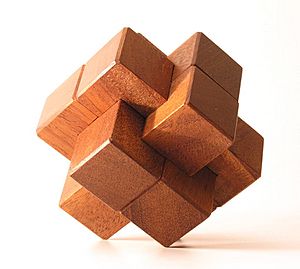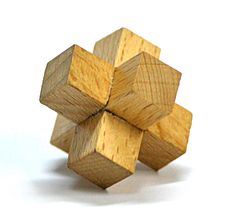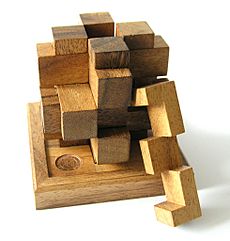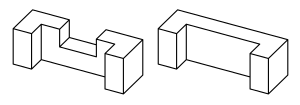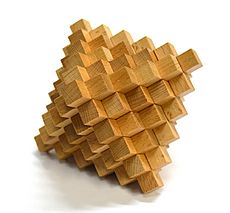Burr puzzle facts for kids
A burr puzzle is a cool type of puzzle made from notched sticks that fit together perfectly to form a three-dimensional shape. They often look symmetrical when finished.
These puzzles are usually made of wood, but you can also find them in plastic or metal. Good quality burr puzzles are made very carefully so the pieces slide easily and fit together just right.
Contents
What is a Six-Piece Burr?
The six-piece burr is probably the most famous and oldest type of burr puzzle. It's also called a "Puzzle Knot" or "Chinese Cross." This is actually a whole family of puzzles that all end up looking the same and have similar pieces. The first time someone got a patent for this kind of puzzle in the US was back in 1917.
For a long time, the six-piece burr was very popular. However, puzzle fans started to find them a bit boring because most of them were very similar. Many had a "key" piece, which was a stick without any notches that could just slide right out.
But in the late 1970s, these puzzles became interesting again! This happened thanks to a smart puzzle designer named Bill Cutler. He used computers to study them, and his findings were shared by Martin Gardner in a popular science magazine.
How Six-Piece Burrs are Made
All six pieces of this puzzle are square sticks that are the same length. When you solve the puzzle, the pieces fit together in three pairs that cross each other. The notches on the sticks are hidden inside the puzzle once it's built.
Imagine the notches are made by removing tiny cube-shaped blocks from the sticks. There are 12 possible spots to remove these blocks. Different puzzles are made from sticks with different blocks removed. There are 837 different kinds of usable pieces!
Theoretically, these pieces could be put together in over 35 billion ways. But it's thought that less than 6 billion of these are actual puzzles that can be put together or taken apart.
Solid Burrs
A solid burr is a burr puzzle that has no empty spaces inside when it's put together. You can usually take these burrs apart by just removing one or more pieces in a single move. Before the late 1970s, most people only paid attention to solid burrs.
There are almost 120,000 possible solid burrs! To build all of them, you would need a collection of 485 different pieces.
Types of Pieces
For looks and, more importantly, for how they are made, burr pieces are put into three groups:
- Notchable pieces: These have simple notches that go straight across the stick. You can make them with a saw.
- Millable pieces: These don't have any tricky inside corners. You can make them with a milling machine.
- Non-notchable pieces: These have inside corners that are hard to make. You might need a chisel or even have to glue parts together.
There are 59 notchable pieces, including a plain stick with no notches. Only 25 of these can be used to make solid burrs. This group of "25 notchable pieces," along with some duplicates, can create 221 different solid burr puzzles! These pieces are very popular, and many companies sell full sets of them.
Holey Burrs and Puzzle Levels
Unlike solid burrs, a holey burr has empty spaces inside when it's assembled. These puzzles can be much harder because they might need more than one move to remove the first piece. The number of moves needed to take out the first piece is called the puzzle's level. So, all solid burrs are level 1. The higher the level, the tougher the puzzle!
In the 1970s and 1980s, puzzle experts tried to find burrs with higher and higher levels. In 1979, an American designer named Stewart Coffin found a level-3 puzzle. In 1985, Bill Cutler found a level-5 burr. Soon after, Philippe Dubois from Israel found a level-7 burr!
In 1990, Bill Cutler finished his big study. He found that the highest possible level for a six-piece burr made with notchable pieces is 5. There are 139 such puzzles! The highest level ever found for a six-piece burr that has more than one solution is 12. This means you'd need 12 moves just to get the first piece out!
Three-Piece Burrs
A three-piece burr made with the usual right-angled notches (like the six-piece burr) can't actually be put together or taken apart. However, there are some three-piece burrs with different kinds of notches. The most famous one was mentioned in a book from 1928. It has a rounded piece that you have to rotate to solve it.
Known Burr Puzzle Families
Altekruse Puzzles
The Altekruse puzzle is named after the person who got a patent for it in 1890. But the puzzle itself was around even earlier! The name "Altekruse" comes from Austrian-German and means "old-cross" in German. Some people thought it was a fake name, but a man named Altekruse did move to America in 1844 to avoid joining the army. He is thought to be the one who patented this puzzle.
A classic Altekruse puzzle has 12 identical pieces. To take it apart, you have to slide two halves of the puzzle in opposite directions. You can also use two more of these pieces to build the puzzle in a different way. You can even make bigger puzzles in this family with 6, 24, 36, or more pieces! Even though they are big, these puzzles aren't considered super hard. But they do need skill and patience to put together.
Chuck Puzzles
The Chuck puzzle was invented by Edward Nelson in 1897. His design was later improved by Ron Cook from a British company called Pentangle Puzzles. Ron Cook designed other puzzles in this family.
Chuck puzzles mostly use U-shaped stick pieces of different lengths. Some pieces have an extra notch and are used as "key" pieces. To make bigger Chuck puzzles (like Papa-chuck or Grandpapachuck), you just add longer pieces. The Chuck puzzle can also be seen as a bigger version of a very simple six-piece burr called Baby-chuck, which is super easy to solve. You can even use Chuck pieces of different lengths to make cool, uneven shapes that still follow the same puzzle rules.
Pagoda Puzzles
No one knows for sure where the Pagoda puzzle, also called "Japanese Crystal," came from. It was mentioned in a book from 1928. Puzzles in this family can be thought of as bigger versions of the "three-piece burr." But unlike some three-piece burrs, they don't need special notches to be put together or taken apart. A Pagoda puzzle of size 2 has 9 pieces. Bigger versions have 19, 33, 51 pieces, and so on.
Diagonal Burrs
Most burr puzzle pieces have square notches. But some are made with diagonal notches! Diagonal burr pieces are square sticks with V-shaped notches cut at a 45° angle from the stick's flat side. These puzzles are often called "stars." This is because the edges of the sticks are also usually cut at a 45° angle for a nice look, making the finished puzzle look like a star.


